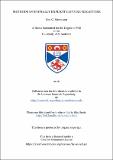Files in this item
Methods in spatially explicit capture-recapture
Item metadata
| dc.contributor.advisor | Borchers, D. L. | |
| dc.contributor.author | Stevenson, Ben C. | |
| dc.coverage.spatial | xvi, 208 p. | en_US |
| dc.date.accessioned | 2019-08-01T15:32:36Z | |
| dc.date.available | 2019-08-01T15:32:36Z | |
| dc.date.issued | 2016-06-24 | |
| dc.identifier.uri | https://hdl.handle.net/10023/18233 | |
| dc.description.abstract | Capture-recapture (CR) methods are a ubiquitous means of estimating animal abundance from wildlife surveys. They rely on the detection and subsequent redetection of individuals over a number of sampling occasions. It is usually necessary for individuals to be recognised upon redetection. Spatially explicit capture-recapture (SECR) methods generalise those of CR by accounting for the locations at which each detection occurs. This allows spatial heterogeneity in detection probabilities to be accounted for: individuals with home-range centres near the detector array are more likely to be detected. They also permit estimation of animal density in addition to abundance. One particular advantage of SECR methods is that they can be used when individuals are detected via the cues they produce---examples include birdsongs detected by microphones and whale surfacings detected by human observers. In such situations each cue may be detected by multiple detectors at different fixed locations. Redetections are then spatial (rather than temporal) in nature, and density can be estimated from a single survey occasion. Existing methods, however, cannot generally be appropriately applied to the resulting cue-detection data without making assumptions that rarely hold. Additionally, they usually estimate cue density rather than animal density, which does not usually have the same biological importance. This thesis extends SECR methodology primarily for the appropriate estimation of animal density from cue-based SECR surveys. These extensions include (i) incorporation of auxiliary survey data into SECR estimators, (ii) appropriate point and variance estimators of animal density for a range of scenarios, and (iii) methods to account for both heterogeneity in detectability and cues that are directional in nature. Moreover, a general class of methods is presented for the estimation of demographic parameters from wildlife surveys on which individuals cannot be recognised. These can variously be applied to CR and---potentially---SECR. | en_US |
| dc.description.sponsorship | "I am grateful to both the Centre for Research into Ecological and Environmental Modelling (CREEM) and the National Centre for Statistical Ecology (NCSE) for studentships that provided funding for my studies. The NCSE studentship was available through a joint grant from the Engineering and Physical Sciences Research Council and the Natural Environment Research Council (#EP/1000917/1). Additional thanks to Auckland Grammar School, New Zealand, for further support through the F. W. W. Rhodes Memorial Scholarship." -- Acknowledgements | en |
| dc.language.iso | en | en_US |
| dc.publisher | University of St Andrews | |
| dc.rights | Attribution-NonCommercial-NoDerivatives 4.0 International | * |
| dc.rights.uri | http://creativecommons.org/licenses/by-nc-nd/4.0/ | * |
| dc.subject | Ecological statistics | en_US |
| dc.subject | Spatial capture-recapture | en_US |
| dc.subject | Mark-recapture | en_US |
| dc.subject | Animal density estimation | en_US |
| dc.subject | Passive acoustic monitoring | en_US |
| dc.subject | Aerial surveys | en_US |
| dc.subject.lcc | QH352.S8 | |
| dc.subject.lcsh | Animal population density--Statistical methods | en |
| dc.subject.lcsh | Ecology--Statistical methods | en |
| dc.title | Methods in spatially explicit capture-recapture | en_US |
| dc.type | Thesis | en_US |
| dc.contributor.sponsor | Engineering and Physical Sciences Research Council (EPSRC) | en_US |
| dc.contributor.sponsor | Natural Environment Research Council (NERC) | en_US |
| dc.type.qualificationlevel | Doctoral | en_US |
| dc.type.qualificationname | PhD Doctor of Philosophy | en_US |
| dc.publisher.institution | The University of St Andrews | en_US |
| dc.publisher.department | Centre for Research into Ecological and Environmental Modelling, School of Mathematics and Statistics | en_US |
The following licence files are associated with this item:
This item appears in the following Collection(s)
Except where otherwise noted within the work, this item's licence for re-use is described as Attribution-NonCommercial-NoDerivatives 4.0 International
Items in the St Andrews Research Repository are protected by copyright, with all rights reserved, unless otherwise indicated.


